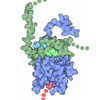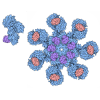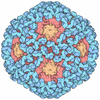[English] 日本語
 Yorodumi
Yorodumi- PDB-6q6h: Cryo-EM structure of the APC/C-Cdc20-Cdk2-cyclinA2-Cks2 complex, ... -
+ Open data
Open data
- Basic information
Basic information
| Entry | Database: PDB / ID: 6q6h | |||||||||
|---|---|---|---|---|---|---|---|---|---|---|
| Title | Cryo-EM structure of the APC/C-Cdc20-Cdk2-cyclinA2-Cks2 complex, the D2 box class | |||||||||
 Components Components |
| |||||||||
 Keywords Keywords | CELL CYCLE / spindle assembly checkpoint / anaphase-promoting complex / cyclin / ubiquitination | |||||||||
| Function / homology |  Function and homology information Function and homology informationmetaphase/anaphase transition of cell cycle / metaphase/anaphase transition of meiosis I / Inhibition of the proteolytic activity of APC/C required for the onset of anaphase by mitotic spindle checkpoint components / mitotic checkpoint complex / positive regulation of anaphase-promoting complex-dependent catabolic process / positive regulation of synapse maturation / regulation of meiotic nuclear division / Conversion from APC/C:Cdc20 to APC/C:Cdh1 in late anaphase / regulation of mitotic cell cycle spindle assembly checkpoint / regulation of dendrite development ...metaphase/anaphase transition of cell cycle / metaphase/anaphase transition of meiosis I / Inhibition of the proteolytic activity of APC/C required for the onset of anaphase by mitotic spindle checkpoint components / mitotic checkpoint complex / positive regulation of anaphase-promoting complex-dependent catabolic process / positive regulation of synapse maturation / regulation of meiotic nuclear division / Conversion from APC/C:Cdc20 to APC/C:Cdh1 in late anaphase / regulation of mitotic cell cycle spindle assembly checkpoint / regulation of dendrite development / Inactivation of APC/C via direct inhibition of the APC/C complex / APC/C:Cdc20 mediated degradation of mitotic proteins / positive regulation of synaptic plasticity / : / anaphase-promoting complex / cyclin A2-CDK1 complex / Phosphorylation of Emi1 / Aberrant regulation of mitotic exit in cancer due to RB1 defects / regulation of meiotic cell cycle / anaphase-promoting complex-dependent catabolic process / metaphase/anaphase transition of mitotic cell cycle / protein branched polyubiquitination / cell cycle G1/S phase transition / cellular response to luteinizing hormone stimulus / Phosphorylation of the APC/C / anaphase-promoting complex binding / regulation of exit from mitosis / positive regulation of dendrite morphogenesis / positive regulation of mitotic metaphase/anaphase transition / positive regulation of ubiquitin protein ligase activity / Transcription of E2F targets under negative control by p107 (RBL1) and p130 (RBL2) in complex with HDAC1 / cellular response to leptin stimulus / ubiquitin ligase activator activity / male pronucleus / protein K11-linked ubiquitination / female pronucleus / cellular response to cocaine / response to glucagon / regulation of mitotic metaphase/anaphase transition / positive regulation of DNA biosynthetic process / cyclin-dependent protein serine/threonine kinase regulator activity / mitotic sister chromatid cohesion / ubiquitin-ubiquitin ligase activity / mitotic metaphase chromosome alignment / cellular response to insulin-like growth factor stimulus / mitotic spindle assembly checkpoint signaling / cyclin A2-CDK2 complex / G2 Phase / p53-Dependent G1 DNA Damage Response / Regulation of APC/C activators between G1/S and early anaphase / regulation of DNA replication / microtubule organizing center / Transcriptional Regulation by VENTX / cullin family protein binding / G0 and Early G1 / cochlea development / Telomere Extension By Telomerase / animal organ regeneration / mitotic spindle assembly / enzyme-substrate adaptor activity / TP53 Regulates Transcription of Genes Involved in G1 Cell Cycle Arrest / positive regulation of axon extension / ubiquitin-like ligase-substrate adaptor activity / protein K48-linked ubiquitination / heterochromatin / Cyclin A:Cdk2-associated events at S phase entry / Cyclin A/B1/B2 associated events during G2/M transition / cyclin-dependent protein kinase holoenzyme complex / intercellular bridge / cellular response to platelet-derived growth factor stimulus / Amplification of signal from unattached kinetochores via a MAD2 inhibitory signal / Mitotic Prometaphase / cellular response to nitric oxide / EML4 and NUDC in mitotic spindle formation / APC/C:Cdc20 mediated degradation of Cyclin B / APC-Cdc20 mediated degradation of Nek2A / nuclear periphery / post-translational protein modification / regulation of mitotic cell cycle / Resolution of Sister Chromatid Cohesion / Autodegradation of Cdh1 by Cdh1:APC/C / APC/C:Cdc20 mediated degradation of Securin / SCF-beta-TrCP mediated degradation of Emi1 / Assembly of the pre-replicative complex / Cdc20:Phospho-APC/C mediated degradation of Cyclin A / cellular response to estradiol stimulus / RHO GTPases Activate Formins / G1/S transition of mitotic cell cycle / APC/C:Cdh1 mediated degradation of Cdc20 and other APC/C:Cdh1 targeted proteins in late mitosis/early G1 / G protein-coupled receptor binding / brain development / kinetochore / DNA Damage/Telomere Stress Induced Senescence / CDK-mediated phosphorylation and removal of Cdc6 / SCF(Skp2)-mediated degradation of p27/p21 / G2/M transition of mitotic cell cycle / histone deacetylase binding / spindle / positive regulation of fibroblast proliferation / Orc1 removal from chromatin Similarity search - Function | |||||||||
| Biological species |  Homo sapiens (human) Homo sapiens (human) | |||||||||
| Method | ELECTRON MICROSCOPY / single particle reconstruction / cryo EM / Resolution: 3.2 Å | |||||||||
 Authors Authors | Zhang, S. / Barford, D. | |||||||||
| Funding support |  United Kingdom, 2items United Kingdom, 2items
| |||||||||
 Citation Citation |  Journal: Nat Commun / Year: 2019 Journal: Nat Commun / Year: 2019Title: Cyclin A2 degradation during the spindle assembly checkpoint requires multiple binding modes to the APC/C. Authors: Suyang Zhang / Thomas Tischer / David Barford /   Abstract: The anaphase-promoting complex/cyclosome (APC/C) orchestrates cell cycle progression by controlling the temporal degradation of specific cell cycle regulators. Although cyclin A2 and cyclin B1 are ...The anaphase-promoting complex/cyclosome (APC/C) orchestrates cell cycle progression by controlling the temporal degradation of specific cell cycle regulators. Although cyclin A2 and cyclin B1 are both targeted for degradation by the APC/C, during the spindle assembly checkpoint (SAC), the mitotic checkpoint complex (MCC) represses APC/C's activity towards cyclin B1, but not cyclin A2. Through structural, biochemical and in vivo analysis, we identify a non-canonical D box (D2) that is critical for cyclin A2 ubiquitination in vitro and degradation in vivo. During the SAC, cyclin A2 is ubiquitinated by the repressed APC/C-MCC, mediated by the cooperative engagement of its KEN and D2 boxes, ABBA motif, and the cofactor Cks. Once the SAC is satisfied, cyclin A2 binds APC/C-Cdc20 through two mutually exclusive binding modes, resulting in differential ubiquitination efficiency. Our findings reveal that a single substrate can engage an E3 ligase through multiple binding modes, affecting its degradation timing and efficiency. | |||||||||
| History |
|
- Structure visualization
Structure visualization
| Movie |
 Movie viewer Movie viewer |
|---|---|
| Structure viewer | Molecule:  Molmil Molmil Jmol/JSmol Jmol/JSmol |
- Downloads & links
Downloads & links
- Download
Download
| PDBx/mmCIF format |  6q6h.cif.gz 6q6h.cif.gz | 1.5 MB | Display |  PDBx/mmCIF format PDBx/mmCIF format |
|---|---|---|---|---|
| PDB format |  pdb6q6h.ent.gz pdb6q6h.ent.gz | 1.2 MB | Display |  PDB format PDB format |
| PDBx/mmJSON format |  6q6h.json.gz 6q6h.json.gz | Tree view |  PDBx/mmJSON format PDBx/mmJSON format | |
| Others |  Other downloads Other downloads |
-Validation report
| Summary document |  6q6h_validation.pdf.gz 6q6h_validation.pdf.gz | 1.4 MB | Display |  wwPDB validaton report wwPDB validaton report |
|---|---|---|---|---|
| Full document |  6q6h_full_validation.pdf.gz 6q6h_full_validation.pdf.gz | 1.5 MB | Display | |
| Data in XML |  6q6h_validation.xml.gz 6q6h_validation.xml.gz | 212.4 KB | Display | |
| Data in CIF |  6q6h_validation.cif.gz 6q6h_validation.cif.gz | 333.5 KB | Display | |
| Arichive directory |  https://data.pdbj.org/pub/pdb/validation_reports/q6/6q6h https://data.pdbj.org/pub/pdb/validation_reports/q6/6q6h ftp://data.pdbj.org/pub/pdb/validation_reports/q6/6q6h ftp://data.pdbj.org/pub/pdb/validation_reports/q6/6q6h | HTTPS FTP |
-Related structure data
| Related structure data |  4466MC  4463C  4464C  4465C  4467C  6q6gC C: citing same article ( M: map data used to model this data |
|---|---|
| Similar structure data |
- Links
Links
- Assembly
Assembly
| Deposited unit | 
|
|---|---|
| 1 |
|
- Components
Components
-Anaphase-promoting complex subunit ... , 10 types, 12 molecules LDNIOCGWMHYZ
| #1: Protein | Mass: 21282.143 Da / Num. of mol.: 1 Source method: isolated from a genetically manipulated source Source: (gene. exp.)  Homo sapiens (human) / Gene: ANAPC10, APC10 / Production host: Homo sapiens (human) / Gene: ANAPC10, APC10 / Production host:  unidentified baculovirus / References: UniProt: Q9UM13 unidentified baculovirus / References: UniProt: Q9UM13 | ||||||
|---|---|---|---|---|---|---|---|
| #2: Protein | Mass: 14286.727 Da / Num. of mol.: 1 Source method: isolated from a genetically manipulated source Source: (gene. exp.)  Homo sapiens (human) / Gene: ANAPC15, C11orf51, HSPC020 / Production host: Homo sapiens (human) / Gene: ANAPC15, C11orf51, HSPC020 / Production host:  unidentified baculovirus / References: UniProt: P60006 unidentified baculovirus / References: UniProt: P60006 | ||||||
| #4: Protein | Mass: 93938.977 Da / Num. of mol.: 1 Source method: isolated from a genetically manipulated source Source: (gene. exp.)  Homo sapiens (human) / Gene: ANAPC2, APC2, KIAA1406 / Production host: Homo sapiens (human) / Gene: ANAPC2, APC2, KIAA1406 / Production host:  unidentified baculovirus / References: UniProt: Q9UJX6 unidentified baculovirus / References: UniProt: Q9UJX6 | ||||||
| #5: Protein | Mass: 92219.227 Da / Num. of mol.: 1 Source method: isolated from a genetically manipulated source Source: (gene. exp.)  Homo sapiens (human) / Gene: ANAPC4, APC4 / Production host: Homo sapiens (human) / Gene: ANAPC4, APC4 / Production host:  unidentified baculovirus / References: UniProt: Q9UJX5 unidentified baculovirus / References: UniProt: Q9UJX5 | ||||||
| #6: Protein | Mass: 85179.766 Da / Num. of mol.: 1 Source method: isolated from a genetically manipulated source Source: (gene. exp.)  Homo sapiens (human) / Gene: ANAPC5, APC5 / Production host: Homo sapiens (human) / Gene: ANAPC5, APC5 / Production host:  unidentified baculovirus / References: UniProt: Q9UJX4 unidentified baculovirus / References: UniProt: Q9UJX4 | ||||||
| #8: Protein | Mass: 9854.647 Da / Num. of mol.: 1 Source method: isolated from a genetically manipulated source Source: (gene. exp.)  Homo sapiens (human) / Gene: ANAPC11, HSPC214 / Production host: Homo sapiens (human) / Gene: ANAPC11, HSPC214 / Production host:  unidentified baculovirus / References: UniProt: Q9NYG5 unidentified baculovirus / References: UniProt: Q9NYG5 | ||||||
| #9: Protein | Mass: 9793.999 Da / Num. of mol.: 2 Source method: isolated from a genetically manipulated source Source: (gene. exp.)  Homo sapiens (human) / Gene: CDC26, ANAPC12, C9orf17 / Production host: Homo sapiens (human) / Gene: CDC26, ANAPC12, C9orf17 / Production host:  unidentified baculovirus / References: UniProt: Q8NHZ8 unidentified baculovirus / References: UniProt: Q8NHZ8#10: Protein | | Mass: 8528.309 Da / Num. of mol.: 1 Source method: isolated from a genetically manipulated source Source: (gene. exp.)  Homo sapiens (human) / Gene: ANAPC13 / Production host: Homo sapiens (human) / Gene: ANAPC13 / Production host:  unidentified baculovirus / References: UniProt: Q9BS18 unidentified baculovirus / References: UniProt: Q9BS18#11: Protein | | Mass: 11677.995 Da / Num. of mol.: 1 Source method: isolated from a genetically manipulated source Source: (gene. exp.)  Homo sapiens (human) / Gene: ANAPC16, C10orf104, CENP-27 / Production host: Homo sapiens (human) / Gene: ANAPC16, C10orf104, CENP-27 / Production host:  unidentified baculovirus / References: UniProt: Q96DE5 unidentified baculovirus / References: UniProt: Q96DE5#13: Protein | Mass: 66929.367 Da / Num. of mol.: 2 Source method: isolated from a genetically manipulated source Source: (gene. exp.)  Homo sapiens (human) / Gene: ANAPC7, APC7 / Production host: Homo sapiens (human) / Gene: ANAPC7, APC7 / Production host:  unidentified baculovirus / References: UniProt: Q9UJX3 unidentified baculovirus / References: UniProt: Q9UJX3 |
-Protein , 2 types, 2 molecules AS
| #3: Protein | Mass: 207240.234 Da / Num. of mol.: 1 / Mutation: deletion of residues 307-395 Source method: isolated from a genetically manipulated source Source: (gene. exp.)  Homo sapiens (human) / Production host: Homo sapiens (human) / Production host:  unidentified baculovirus / References: UniProt: Q9H1A4*PLUS unidentified baculovirus / References: UniProt: Q9H1A4*PLUS |
|---|---|
| #16: Protein | Mass: 44427.766 Da / Num. of mol.: 1 Source method: isolated from a genetically manipulated source Source: (gene. exp.)  Homo sapiens (human) / Gene: CCNA2, CCN1, CCNA / Production host: Homo sapiens (human) / Gene: CCNA2, CCN1, CCNA / Production host:  |
-Cell division cycle protein ... , 4 types, 7 molecules KQJPUVR
| #7: Protein | Mass: 71747.516 Da / Num. of mol.: 2 Source method: isolated from a genetically manipulated source Source: (gene. exp.)  Homo sapiens (human) / Gene: CDC16, ANAPC6 / Production host: Homo sapiens (human) / Gene: CDC16, ANAPC6 / Production host:  unidentified baculovirus / References: UniProt: Q13042 unidentified baculovirus / References: UniProt: Q13042#12: Protein | Mass: 91973.125 Da / Num. of mol.: 2 Source method: isolated from a genetically manipulated source Source: (gene. exp.)  Homo sapiens (human) / Gene: CDC27, ANAPC3, D0S1430E, D17S978E / Production host: Homo sapiens (human) / Gene: CDC27, ANAPC3, D0S1430E, D17S978E / Production host:  unidentified baculovirus / References: UniProt: P30260 unidentified baculovirus / References: UniProt: P30260#14: Protein | Mass: 68921.031 Da / Num. of mol.: 2 Source method: isolated from a genetically manipulated source Source: (gene. exp.)  Homo sapiens (human) / Gene: CDC23, ANAPC8 / Production host: Homo sapiens (human) / Gene: CDC23, ANAPC8 / Production host:  unidentified baculovirus / References: UniProt: Q9UJX2 unidentified baculovirus / References: UniProt: Q9UJX2#15: Protein | | Mass: 54796.508 Da / Num. of mol.: 1 Source method: isolated from a genetically manipulated source Source: (gene. exp.)  Homo sapiens (human) / Gene: CDC20 / Production host: Homo sapiens (human) / Gene: CDC20 / Production host:  unidentified baculovirus / References: UniProt: Q12834 unidentified baculovirus / References: UniProt: Q12834 |
|---|
-Experimental details
-Experiment
| Experiment | Method: ELECTRON MICROSCOPY |
|---|---|
| EM experiment | Aggregation state: PARTICLE / 3D reconstruction method: single particle reconstruction |
- Sample preparation
Sample preparation
| Component |
| ||||||||||||||||||||||||
|---|---|---|---|---|---|---|---|---|---|---|---|---|---|---|---|---|---|---|---|---|---|---|---|---|---|
| Molecular weight | Value: 1.3 MDa | ||||||||||||||||||||||||
| Source (natural) |
| ||||||||||||||||||||||||
| Source (recombinant) |
| ||||||||||||||||||||||||
| Buffer solution | pH: 8 / Details: 20mM Hepes, 150mM NaCl, 0.5mM TCEP | ||||||||||||||||||||||||
| Specimen | Conc.: 0.15 mg/ml / Embedding applied: NO / Shadowing applied: NO / Staining applied: NO / Vitrification applied: YES | ||||||||||||||||||||||||
| Vitrification | Cryogen name: ETHANE |
- Electron microscopy imaging
Electron microscopy imaging
| Experimental equipment |  Model: Titan Krios / Image courtesy: FEI Company |
|---|---|
| Microscopy | Model: FEI TITAN KRIOS |
| Electron gun | Electron source:  FIELD EMISSION GUN / Accelerating voltage: 300 kV / Illumination mode: FLOOD BEAM FIELD EMISSION GUN / Accelerating voltage: 300 kV / Illumination mode: FLOOD BEAM |
| Electron lens | Mode: BRIGHT FIELD |
| Image recording | Electron dose: 28 e/Å2 / Film or detector model: GATAN K2 SUMMIT (4k x 4k) |
- Processing
Processing
| EM software | Name: RELION / Version: 3 / Category: 3D reconstruction |
|---|---|
| CTF correction | Type: PHASE FLIPPING AND AMPLITUDE CORRECTION |
| Symmetry | Point symmetry: C1 (asymmetric) |
| 3D reconstruction | Resolution: 3.2 Å / Resolution method: FSC 0.143 CUT-OFF / Num. of particles: 117044 / Symmetry type: POINT |
 Movie
Movie Controller
Controller


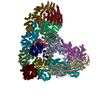


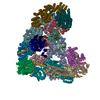






 PDBj
PDBj


